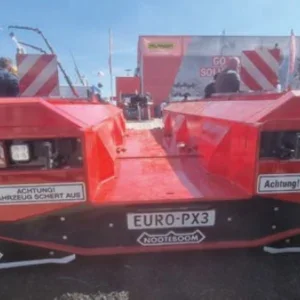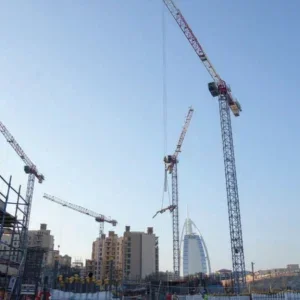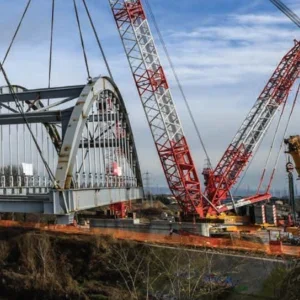Odessa, Ukraine, based Transship specialises in the transhipment of cargo and containers, working from a fleet of floating cranes in the Kerch Straits, the narrow channel connecting the Sea of Azov to the Black Sea. One of its specialties is the transfer of grain, coming from the fertile fields of Ukraine, to seagoing vessels, for delivery across the Black Sea, out to the Mediterranean and beyond.
Transship currently has Liebherr CBG 300 high performance bulk handling cranes fitted on two barges in the straits, the Atlas-1 and Atlas-4. The cranes are built to load and unload vessels, all the way up to capsize.
These Liebherr CBG 300 cranes have a maximum lifting capacity of 25 tonnes in grab operation with a jib outreach of 30 metres. This outreach is extended through an ex-centre arm of 10 m and 6 m respectively, making a total outreach of 40 m and 36 m. This means that it is not necessary to reposition the crane to reach all holds during unloading, and the cycle can be reduced by approximately 20% in comparison to conventional cranes. The barges Atlas-1 and Atlas-4 can transship 600,000t–800,000t of cargo each within a navigation period of 200 days. During the peak season for grain each crane transhipped around 200,000t of grain per month, limited only by the lack of barges and not crane turnover.
Two further Liebherr cranes type CBG 300 have recently been installed on Transship’s new vessel the Alina, which has a buffer capacity of 30,000t. These two cranes also have lifting capacities of 25t at 30m outreach (40m including the ex-centre arm).
The Liebherr range of CBG four-rope grab cranes is designed for high speed and continuous performance, and all three motions can be operated simultaneously at full speed. A wide rope field for stabilising the grab ensures safe operation and cargo handling without the need of an additional stabilizing winch. Specially designed heavy duty hoisting winches, heel trim alarm systems and emergency operation functions make these cranes suitable for operation in heavy sea state condition. According to Transship Ltd., the two barges fitted with Liebherr FCC CBG floating cranes are conclusively better adjusted to bad weather conditions than other floating cranes.
Precision and safety are of utmost importance and are supported by Liebherr’s own Litronic crane control and management system. This system controls the simultaneous operation of crane motions (luffing, hoisting and slewing), so ensuring best possible performance and protection for the crane. It also records data about all individual components, all alarm signals and failures as well as peak values. The lifetime of components can thus be analysed and plans for preventative maintenance and spare parts supply can be established. Relevant values such as load indication/limitation, operation mode, etc. are displayed on the LCD monitor in the cabin.
To complement the support of Liebherr’s world-wide service network, these FCC CBG cranes are equipped with a modem for data-transfer enabling remote diagnosis. This allows for system checks as well as fault-finding which can cost-effectively be carried out without the presence of a service engineer.
Looking to the future
While Liebherr looks to provide one of the most up to date solutions for regular users around the world, the US Navy’s Office of Naval Research (ONR) is looking to the future. A new project, the Large Vessel Interface Lift On/Lift Off (LVI Li/Lo) system, has been developed to handle transshipment in rough seas.
The system has been under development by the US Office of Naval Research (ONR) and contractor Oceaneering Advanced Technology for the past six years. The project was developed as part of the US Navy’s Sea Base Concept, which envisages the capacity to establish ‘Sea Bases’ or offshore floating ports that would allow the Navy to ensure logistics flow between ships without securing a deep harbour.
US ONR programme manager Paul Hess says, “In a lot of recent events, both military or humanitarian, we’ve had a lot of challenges to move supplies inland, without safe harbours. There is only so much you can do with helicopters.
“The thinking behind the sea base concept is to be able to get in container ships, and then move cargo to smaller ships that are able to go into more austere environments.”
Recent examples of where this sort of transshipment has been needed include Haiti, where Port-au-Prince’s harbour was destroyed by the earthquake that devastated the country, and Thailand, where the navy flew in post-tsunami supplies by helicopter.
The cranes built by Liebherr, or rivals such as Gottwald, are perfectly suited to transshipment in calm waters. The ONR’s aim was to develop a system that could work in tougher conditions. Hess says, “We want to work with waves of up to 2.5m; sea state 3 or sea state 4, in naval architecture terms. The intent was to be able to work offshore, where you have no protected port or wave breaks.”
The system could offer a new approach to container handling, both in ports that are frequently subject to poor weather conditions, and in the offshore sector. The ONR’s partner on the project, Oceaneering, is working on commercialising the technology.
Hess says, “In some ports, they have to stop work during bad weather. On offshore platforms, they have a lot of replenishment needs, and that is severely sea state limited.”
Hess explains, “It relies on a sensor package to understand the relative motion between platforms. There are no tag lines, no need for people guiding the payload. That input data makes the system simple to operate.
“The control systems are based on a commercially available MacGregor crane. The system is adapted to invisibly control the extra joints, allowing the operator to work with a joystick.
“It’s like operating a marionette puppet. The macro crane is as normal, but the micro crane adds eight sets of cables and extra joints to control the spreader, to an accuracy of less than an inch.”
A demonstrator version of the system was installed on the SS Flickertail State in 2009. Earlier in 2010, the Flickertail State performed tests of the system in the Gulf of Mexico, safely transferring 128 containers from one ship to another, with a significant wave height of 1m. The crane’s operators were able to lift and place unobstructed containers, to lift containers obstructed on multiple sides, and to place containers into obstructed holes in a container pile.
The ONR’s specification for LVI Li/Lo calls for it to be able to maintain optimal cargo throughput rates through Sea State 4 (when waves can reach from 1.25–2.5m). It should be able to transfer cargo between two ships directly alongside each other at zero forward speed or underway at slow speed in the open ocean. Motion sensing and compensation for the ships and/or the cranes should allow safe and efficient transfer of cargo.
Oceaneering said its OTECH division’s effort had concentrated on the science and technologies required for a crane to move large containers between ships while they are underway. The control system was proven through the use of a 1/20th scale version of the crane that included all electrical sensor hardware interfaces, including motion sensors. The Large- Scale Demonstrator reaches 85ft and can lift a 20,000 lb container in Sea State 4, and 40,000lb in Sea State 3.






